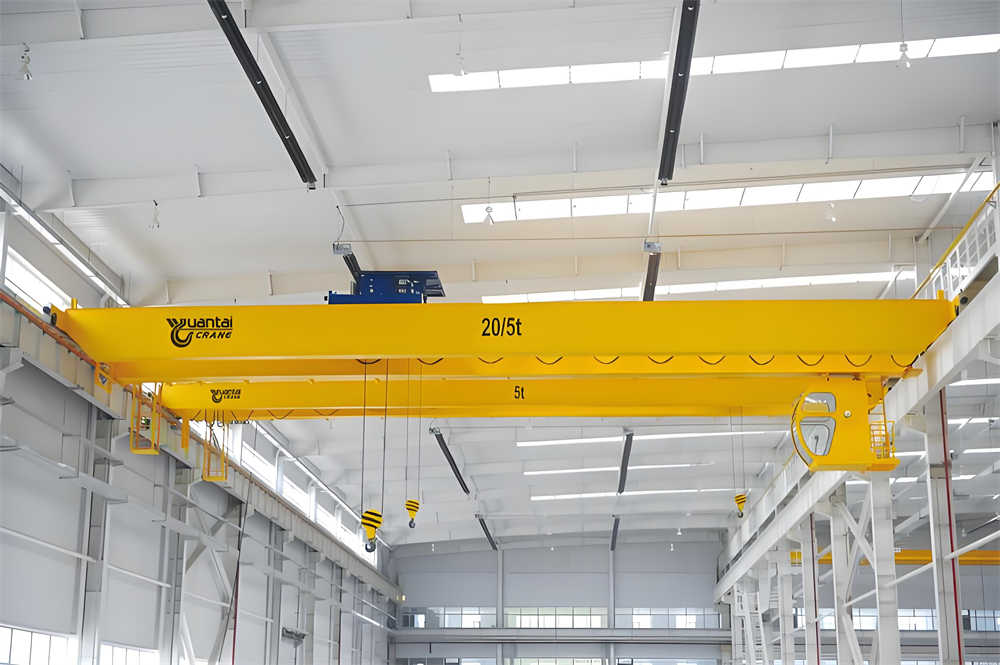11-Mar-2025
63/20t Double Girder Overhead Travelling Crane: A Comprehensive Guide for Singapore’s Industrial Needs
As a cornerstone of heavy industrial equipment, the 63/20t double girder overhead travelling crane with a 25.5-meter span is a critical asset in modern manufacturing and logistics. Its structural design not only ensures the efficiency and safety of lifting operations but also reflects the advanced level of manufacturing technology. This manual provides a detailed technical reference for manufacturing, installation, maintenance, and operation personnel, tailored specifically for Singapore’s industrial environment. By exploring the design concepts, structural composition, force analysis, material technology, and safety measures, this document highlights the crane’s exceptional performance and reliability in Singapore’s demanding industrial settings.
Crane Overview
The double girder overhead travelling crane is a leader in heavy machinery, essential for industrial production. Its unique design features two parallel, sturdy main girders connected by end girders, forming a robust frame structure. This design ensures smooth horizontal movement along the plant’s tracks, enhancing stability, safety, and efficiency—key requirements for Singapore’s industrial applications.

Key Technical Specifications
- Rated Load Capacity: 63/20 tons
- Span: 25.5 meters
- Lifting Height: Customizable to meet user requirements
- Work Class: A5 (suitable for frequent use)
- Operating Speeds: Lifting, trolley, and crane speeds are optimized for efficiency.
- Environmental Adaptability: Designed to operate reliably in Singapore’s high-temperature, high-humidity conditions.
Application Scenarios and Demand Analysis
In Singapore, double girder overhead cranes are indispensable in industries such as:
- Steel Mills: For handling heavy steel coils and slabs.
- Heavy Machinery Manufacturing: For assembling and transporting large components.
- Port Terminals: For loading and unloading heavy cargo.
The crane’s design ensures efficiency, safety, and stability, even in challenging environments. For example:
- High-Temperature Environments: High-temperature-resistant materials and designs are used.
- Humid and Corrosive Environments: Anti-corrosion treatments are applied to enhance durability.
Design Principles and Standards
Design Principles
The crane is designed with the core principles of safety, reliability, economy, and efficiency. Key considerations include:
- Structural Optimization: Ensuring stability under maximum load conditions.
- Maintainability and Expandability: Pre-designed interfaces for future upgrades and easy maintenance.
Standards and Compliance
The crane adheres to stringent international and local standards, including:
- Crane Design Code (GB/T 3811): Specifies structural design, strength calculations, material selection, and safety requirements.
- Crane Safety Regulations (GB 6067): Ensures safety in design, manufacturing, installation, and operation.
- Singapore Standards: Compliance with local regulations and industry-specific requirements.
Structural Composition and Component Design
Main Girder Design
The main girder, the core load-bearing component, uses an advanced box structure for high strength, stiffness, and stability. Finite element analysis ensures it can withstand maximum loads without deformation. High-strength low-alloy steel is used for durability, and heat treatment enhances material uniformity.
Auxiliary and End Girder Design
The auxiliary and end girders are designed to provide stable support and load-bearing capacity. High-strength bolts and welding ensure secure connections, while wheel sets enable smooth operation on tracks.
Hoisting Mechanism
The hoisting mechanism, available as an electric hoist or winch, is customized for Singapore’s industrial needs. It includes braking and limit devices for safety and stability.
Operating Mechanism
The trolley and crane operating mechanisms ensure smooth lateral and longitudinal movement. Motors, reducers, and wheels are selected for stability and load-bearing capacity.
Force Analysis and Calculations
Static and Dynamic Force Analysis
- Static Analysis: Ensures the crane can handle maximum loads without structural failure.
- Dynamic Analysis: Evaluates the impact of dynamic loads during startup, braking, and operation to prevent resonance or instability.
Stress and Deformation Calculations
Finite element analysis provides detailed stress distribution and deformation data, ensuring components meet design requirements.
Stability and Safety Assessment
The crane’s stability is assessed to prevent tipping or slipping. Safety devices such as anti-tipping and anti-slip systems are integrated for reliable operation.
Material Selection and Process Requirements
Main Material Selection
- High-Strength Low-Alloy Steel: Used for structural components to ensure durability and load-bearing capacity.
- Castings and Forgings: Used for complex parts like gears and bearing seats, made from high-quality alloy materials.
Manufacturing Processes
- Welding: Ensures reliable weld quality.
- Heat Treatment: Enhances material properties.
- Machining: Ensures dimensional accuracy and surface quality.
Corrosion Prevention and Surface Treatment
Anti-corrosion treatments, including sandblasting and painting, are applied to withstand Singapore’s humid and corrosive environments.
Safety Devices and Protective Measures
Limit and Anti-Collision Devices
- Limit Devices: Control the crane’s operating range to prevent accidents.
- Anti-Collision Systems: Use sensors and cameras to monitor surroundings and prevent collisions.
Overload Protection
High-precision sensors monitor load conditions, automatically cutting power or issuing alarms if the load exceeds capacity.
Electrical Safety Devices
- Leakage Protectors: Prevent electric shocks and fire hazards.
- Short-Circuit Protection: Safeguards electrical circuits.
- Grounding Protection: Ensures safe grounding of metal components.
Maintenance and Repair Safety Measures
Regular maintenance and safety inspections are conducted to ensure long-term reliability. Safety protocols are followed during repairs to minimize risks.

Installation, Commissioning, and Acceptance
Pre-Installation Preparation
- Site cleaning and equipment inspection.
- Development of detailed installation plans and schedules.
- Training for installation personnel.
Installation Steps
- Foundation construction.
- Equipment installation and alignment.
- Commissioning and functional testing.
Acceptance Criteria and Procedures
Comprehensive inspections and tests are conducted to ensure compliance with design and safety standards.
Maintenance and Upkeep
Daily Maintenance and Inspection
- Regular cleaning, lubrication, and fastener checks.
- Monitoring of equipment operation and performance.
Fault Diagnosis and Troubleshooting
Prompt identification and resolution of issues to minimize downtime.
Major Repairs and Upgrades
Periodic overhauls and upgrades to maintain performance and extend service life.
Maintenance Plans and Records
Detailed maintenance schedules and records ensure timely and effective upkeep.
Conclusion
The 63/20t double girder overhead travelling crane is a robust and reliable solution for Singapore’s heavy industrial applications. Its advanced design, adherence to safety standards, and adaptability to challenging environments make it an indispensable asset for industries such as steel manufacturing, heavy machinery, and port operations. By following rigorous maintenance and safety protocols, this crane ensures long-term efficiency and reliability, supporting Singapore’s industrial growth and development.

